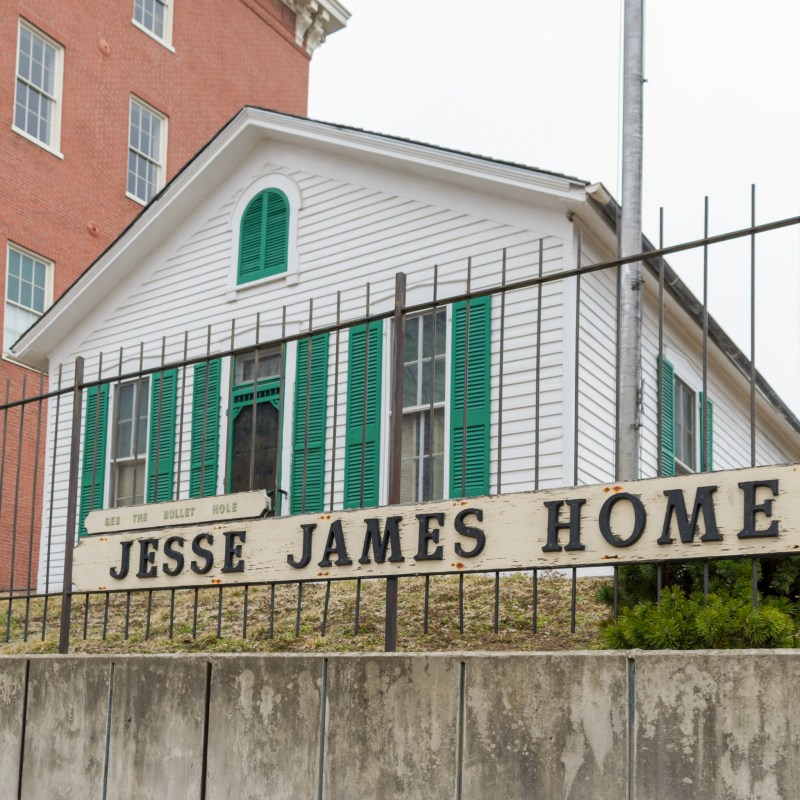
Considered America’s first celebrity criminal, Jesse James impacted Midwestern towns from Missouri to Minnesota. Known for several firsts, including the first daytime bank heist and train robbery, the Missouri native lived an exciting life for the times. As part of a Confederate-loyal group, he and brother Frank conducted several guerilla raids in Missouri.
Videos by TravelAwaits
James is best known for his postwar criminal career. As part of the James-Younger Gang (he and Frank teamed with their cousins to form the gang), James was involved in nearly 20 robberies between 1869 and 1881, along with 20 deaths (including some gang members), from as far south as Texas and east to West Virginia. The gang primarily operated in the Midwest, including a bank robbery in Liberty, Missouri, and a shootout in Northfield, Minnesota. James was known to use Nebraska connections when he needed places to hide out, which included Rulo in southeast Nebraska and the Devil’s Nest region in the state’s northeastern area. While at Devil’s Nest, it’s believed James married a member of the Santee Dakota Native American nation and has descendants there today.
Nationally, the press and public became infatuated with James and turned him into the country’s first celebrity bad guy. Thus, the Midwest is home to several attractions related to the outlaw.
1. Childhood Home
Kearney, Missouri
Jesse James’s road to a criminal life began on the family farm near Kearney, about 30 minutes northeast of Kansas City. Originally a three-room cabin, an addition was added following his death. You’ll learn about the family’s history, such as James’s father being a Baptist minister and the suspicious death of James’s first stepfather.
The family operated the farm for several years and was once forced off it due to financial issues. You’ll see family artifacts, such as weapons, during your visit. Following James’s death, his mother and brother Frank (yes, his partner in crime) would lead tours. You can also visit James’s original gravesite on the farm. He was later moved to the local cemetery, where he’s buried alongside family members.
2. Bank Robbery
Liberty, Missouri
On a cold, snowy February day in 1866, a small bank on the corner of Liberty’s main street sat empty, except for the local banker and his young son. A stranger walked in, stood near the wood-burning stove to warm his hands. Then, as he approached the counter, he asked the banker if he could cash a certificate. As the banker turned to open the bank vault, Frank James pulled a pistol and jumped onto the counter and announced the bank robbery. A second gang member joined him inside. Outside, among the horses and other gang members, Jesse James sat on his horse, awaiting his brother’s exit and a quick escape from the Missouri town.
The Jesse James Bank Museum highlights the story of the nation’s first daytime bank robbery. With artifacts from the bank’s era, the museum shares the story of how the gang made their way out of town. Along the way, the cowboys fired several rounds to create a diversion, with one of the bullets striking and killing a 17-year-old college student, who had been walking along the street. The gang managed to beat the town’s posse to a ferry and escape across a river into the winter snow. The James-Younger Gang stole $60,000, equivalent to about one million today. The eight-year-old bank was unable to bounce back and was forced to close.
3. Train Robbery
Adair, Iowa
Having been credited as the first gang to rob a moving train, Jesse James and his cohorts robbed the Chicago, Rock Island, and Pacific Railroad train west of Adair the night of July 21, 1873. You can find a marker at the Jesse James Historical Site just off Exit 75 on Interstate 80. James sent Frank and Cole Younger to Omaha to research when a train would be carrying about $75,000 in gold. Meanwhile, Jesse and others broke off a connection piece on the railroad and tied a rope to a rail, which they pulled away from the track, forcing the train to derail. The engineer immediately died, and another person later died from injuries. The gold wasn’t aboard that train, so the gang came away from the robbery with about $3,000. There is some belief that the Reno brothers actually pulled off the first moving train robbery in 1866. But, we’ll let the James-Reno aficionados debate that.

4. Meramec Caverns
Stanton, Missouri
Needing safe places to hide from the law, Jesse and Frank James found unique places, often caves. One such place they are believed to have used as a hideout is Meramec Caverns near Stanton, Missouri. You’ll notice the statue of two bank robbers near the entrance of the caverns. Are they the James brothers? Having served as military headquarters for both the Union and Confederate militaries during the Civil War, the James brothers were familiar with the cave from their time with the Confederacy. As you tour the caverns, with their unique formations hanging from the ceiling and rising from the floor, it’s easy to understand how the James brothers could tuck themselves away, unable to be detected by a posse. With a temperature around 60 degrees Fahrenheit, the caves are perfect year-round.
5. Jesse James Wax Museum
Stanton, Missouri
Near Meramec Caverns, the Jesse James Wax Museum presents the case that James faked his death in 1882 and later lived in the Stanton area. You’ll see a film highlighting James’s life as well as wax figures depicting scenes during his life. Artifacts related to the James brothers and a gun collection can also be found at the museum.
6. Northfield Bank Robbery
Northfield, Minnesota
Northfield’s residents didn’t practice “Minnesota Nice” when it came to the James-Younger Gang. In September 1876, the gang traveled north to the south-central Minnesota town, where they spent two weeks scouting the bank. Planning a major heist, Frank James and another gang member entered the bank. Jumping on top of the bank counter, Frank demanded the banker open the vault. After claiming he couldn’t unlock it, Frank fired a shot into the floor, near Joseph Lee Heywood. Frank again demanded he open the vault. As this took place, a man walking past the bank noticed the robbery and alerted townspeople. As men carrying weapons headed toward the bank, a shootout ensued.
You can still see bullet holes in the side of the bank, now the James-Younger Gang Bank Raid museum. As he exited the bank, Frank grabbed the money in one drawer, taking about $27. The next drawer contained $3,000. Staring Heywood in the eye, Frank pulled his pistol’s trigger, killing the banker. While the bandits made their getaway, Cole and Bob Younger were each wounded, and two other gang members were killed by locals. Heywood was considered a hero, saving the bank’s $15,000 (about $250,000 today). Today, the city celebrates the event with the Defeat of Jesse James Days each September.
7. Rock Island Train Depot
Winston, Missouri
The small-town Winston train depot, called Rock Island Station at the time, was one of the last robberies by the James Gang. During the summer of 1881, Jesse and Frank each shot and killed a man during the robbery. They jumped off a moving train and managed to escape. However, their reign of terror would soon end. Today, Winston celebrates its connection to the James gang with an annual Jesse James festival.

8. Jesse James Home
Saint Joseph, Missouri
The Legend of Jesse James ends in Saint Joseph, Missouri. At the age of 34, the infamous bank robber met his fate at the Jesse James Home when Robert Ford assassinated him on April 3, 1882. Ford, who allegedly decided the Missouri governor’s reward of $10,000 was worth risking his own life, shot James, as the outlaw stood on a chair with his back to him, adjusting a frame on the wall. The small farmhouse was relocated to downtown Saint Joseph, next door to the Patee Hotel Museum. You can see the hole in the wall where one bullet struck.
9. Jesse James Casket
Saint Joseph, Missouri
Among the oddities at the small museum at the Heaton-Bowman-Smith and Sidenfaden Funeral Chapel is the casket used to transport Jesse James from his home to a local caretaker following his death. The casket includes photographs and other Jesse James artifacts. The museum also includes one of two known ice caskets still in existence. The Smithsonian tried to sway the funeral owners to part with it, but they’ve declined.

